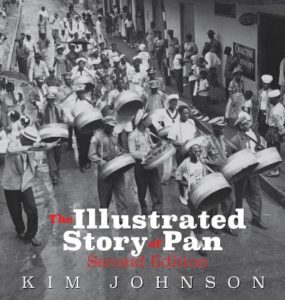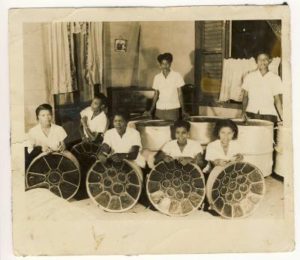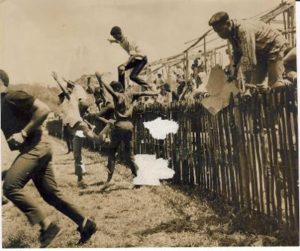|
Getting your Trinity Audio player ready...
|
Reading Time 6 mins
April 16, 2021
To those who think that pan arrive out of the blue: that pan has no soul, no identity; that pan has no place in society; that pan is just another thing that them ragamuffin used to do or started, so, it has no substance; it doesn’t belong; is nothing to be proud about – Well, you better read this book.
place in society; that pan is just another thing that them ragamuffin used to do or started, so, it has no substance; it doesn’t belong; is nothing to be proud about – Well, you better read this book.
This Illustrated Story of Pan is a classic. Johnson’s 304-page book is a pleasure to behold as it captures pan — its deep past and evolution. Kim Johnson went beyond himself. You can see and feel the pain, the anguish, the disappointments—the challenges endured to produce pan and this masterpiece.
The children need to access this book because they join pansides; they beat pan and play pan in schools; therefore, they need to know more about their instrument. Many may not know where it came from, and even fewer may understand how it became so engraved in Trinbagonian society. They may be unaware that every village, almost every street, had a little panside. They don’t know that even those who couldn’t get to the band would make their little tin pan and pound it out, and you would hear the rhythm in the air.
One would not have associated pan with Christmas. Early in the book, page eleven, to be exact, there is an iconic image that features a group of young boys with mini pans, maracas, and a rhythm section. One of the boys who is “beating iron” is seen with a gun and holster (sack) strung on his waist. To the clever observer, this is Christmas time. Every boy yearned to have a toy gun to play “Stick ’em Up.” Christmas without a Panside coming out on the road to serenade you was no Christmas at all, even if “yuh ‘fraid” to go and join them.
Those of us fortunate to live close to the pioneers would tell you that almost every street had somebody beating a pan. Yes, the Story would say to you that every street had somebody beating a pan. Yes, the Story would tell you, as Sparrow did in “Outcast,” “If your sister talk to a steel band man… you family want to break she hand; put she out; lick out every teeth in she mouth.”
Yeah, but this pan thing, as the book would tell you, continues to thrive. It continued because the same ragamuffins and badjohns who put pan on the streets are the ones who stuck with it, who passed it on, who taught it to those who were able to access it so that, today, we have these dynamic orchestras.
Trinidad All-Stars Woman on the Bass, “The most played pan recording in history.”
We have these champions. We revel in them today; we admire them; we break down the Grand Stand and the North Stand to listen to them play.
When did it all start? Where did “this thing” come from? Where is this majestic song/sound coming from? Who started this? We now know, and it is alive. The history in this book is living history. I found myself delving into this tome, and I had to prize myself away from it. I had to lift myself away from it.
The pages took me back into an age of glory. Into an era of manliness, when men were men. Men would stand and fight like a man; fistfight. Men will stand up against the police for the instrument they created. It resounded in in their souls; it was spiritual!
Kim Johnson takes us through time, showing how “this thing” evolved. Showing how pan made men into panjumbies. Look at their creative genius. It shows how pan united Africans and Indians. Something that many of us didn’t know. East Indians played a significant role in the development of pan.
This volume gave me an out-of-body experience. It was as though I had died and come back alive because I saw before me in Pan, the life that we lived. I was alive again! I was surrounded by pan: Pan in the East, pan in the West, pan up North, pan down South, and pan in Tobago. Indeed, Pan Everywhere!
It reminded me of the nights I would go from panside to panside, all within proximity to each other. Being able to identify which pan was playing by the sound. By their uniqueness.
Johnson’s book took me to a space where I could be up close to the geniuses and see them at work. These were musical geniuses. These were the Beethovens, the Bachs, the Mozart, the Tchaikovsky’s of this pan world. They created and arranged classical music pieces on their pans that rivaled any renowned symphony orchestra. Our pan geniuses were not only musically gifted, but they were also incredibly innovative. Included among their many innovations were: the spider web tenor pan by Anthony Williams; the double tenor pan and canopies over the pans by Bertie Marshall; the nine bass and chromed pans by Rudolph Charles and the triple cello by Ellie Manette. Had these pan geniuses been of another ilk, their contributions to music would have been pasted in all the museums of the world.
This book should be in every library, not only in Trinidad and Tobago but throughout the world. Pan is world music. This pan is a world musical instrument and an invention that we should be proud of. It’s an innovation that should be cherished and preserved, a device that can hold its own with any musical instrument ever invented. Indeed, Johnson makes us hold out our chest like fancy sailors playing in City Syncopators and boast like Mudada, Trinidad is “The Mecca of Steelband.”
This Story of Pan is well-researched. And it’s not only a look at the pan itself, but we look at the lifestyle; the romantic lifestyle, the chivalry. No, it’s not tribalism, for it captures, in words and images, the life lived by our menfolk. I found myself in this book when I was in transition. While I was in this surrealistic world, I saw myself pushing pan on Park Street. Bomb Competition and I am there pushing pan, ensuring that my pan beaters were comfortable. They were able to play their pan. Highlanders’ tenors ringing out on Park Street, and I am there overlooking these pan greats, these talented panists making the cello talk.
Let Every Valley be Exalted is ringing in my ears. Everywhere we go, we hear the talk; Let Every Valley be Exalted. I had to choose between Highlanders and Desperadoes. Laventille, I love them both. What was more exciting — you pushing pan, and then you only hear; palang, palang. Pan drop; a man running. Bottles in the air. Look at me; I actually see myself running, running down St Vincent Street. Look at me on Tragarette Road — Invaders coming down. Men bareback and in short khaki pants, beating/playing the hit tune of the year. They “eh fraid” nobody. Pan in its glory!
I visualize the Panorama Finals scenario. Look! Look at me jumping the Savannah fence, storming to go Panorama to be enthralled by the melodious tenors, feel the pulsating vibrations of the rhythm sections, and be absorbed by the mighty humming of the bass pans, a la Guinness Cavaliers.
Indeed, the brilliance of this masterpiece led me to reflect on Cro Cro’s lament, “Whey pan reach, whey the hell pan reach”? No one has offered a proper response to that question to my recollection. Maybe a little mamaguy at a prize-giving or some other public event. Read Johnson’s The Illustrated Story of Pan, and you will not only learn where pan started, but where it reached and where it is heading. Kim provides revolutionary approaches that can help take pan to a higher level.

Laventille All Girls Steelband in Pearl Simon’s living room. Elma, E. Drayton, J. Black, P. Simon, Joyce (unknown), J. Simon and Cynthia Yuille. Photo courtesy of C. Yuille.
Had Johnson not written this book, we might not have fully grasped how pan and Steelband are interwoven in communities. We would not have understood why Dem Boys from Belmont brought out so many women in their band. We would not have understood why women eventually gravitated to pan and its players labeled as “outcasts“ in the early days.
The book captures the pan drama’s full eccentricities from inception to these present times. We are fed every single morsel placed on the historical platter of Pan. The Illustrated Story is profound; it is factual; it is credible. The author has proven that the instrument called pan can transcend the racial differences, cultural diversity, and social mores of the land of its birth.
This collectors’ item is a classic — a masterpiece. Those in authority should make this volume accessible to all school children and all libraries. Deny yourself a copy of The Illustrated Story of Pan by Kim Johnson and remain culturally malnourished and impoverished. Nuff said.
*Click here to order The Illustrated Story of Pan.
Monty Guy is a retired pan-pusher.




